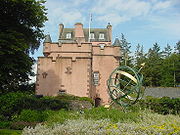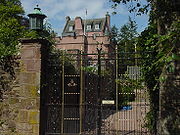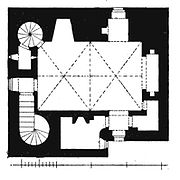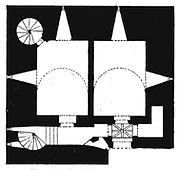
Towie Barclay Castle
Encyclopedia




Castles in Scotland
This list of castles in Scotland is a link page for any castle in Scotland.A castle is a type of fortified structure built during the Middle Ages. Scholars debate the scope of the word castle, but usually consider it to be the private fortified residence of a lord or noble...
in Aberdeenshire
Aberdeenshire
Aberdeenshire is one of the 32 unitary council areas in Scotland and a lieutenancy area.The present day Aberdeenshire council area does not include the City of Aberdeen, now a separate council area, from which its name derives. Together, the modern council area and the city formed historic...
, Scotland
Scotland
Scotland is a country that is part of the United Kingdom. Occupying the northern third of the island of Great Britain, it shares a border with England to the south and is bounded by the North Sea to the east, the Atlantic Ocean to the north and west, and the North Channel and Irish Sea to the...
, 4.5 miles south-south-east of Turriff
Turriff
Turriff is a town and civil parish in Aberdeenshire in Scotland. It is approximately above sea level, and has a population of 5,708.Turriff is known locally as Turra in the Doric dialect of Scots...
. The current structure was built in 1593 by Clan Barclay
Clan Barclay
-Origins of the clan:Since the eighteenth century, Barclay historians, noted for their low level in medieval scholarship, have assumed the Scottish family Barclay is a branch of one of the Anglo-Norman Berkeley family of Berkeley in Gloucestershire...
. The site was gifted to the Clan in the 11th century by Malcolm III of Scotland
Malcolm III of Scotland
Máel Coluim mac Donnchada , was King of Scots...
. Following Clan Barclay's pillage of a nunnery in the 12th century, Thomas the Rhymer
Thomas the Rhymer
Thomas Learmonth , better known as Thomas the Rhymer or True Thomas, was a 13th century Scottish laird and reputed prophet from Earlston . He is also the protagonist of the ballad "Thomas the Rhymer"...
proclaimed: "Towie Barclay of the Glen/Happy to the maids/But never to the men.", which was interpreted as a curse on the male line. Belief in the curse was strong enough that it was given as a reason for the sale of Towie Barclay Castle in 1755.
The building was sold to the governors of Robert Gordon's hospital in Aberdeen for £21,000. Despite a reroofing project in 1874, Towie Barclay Castle had fallen into a state of neglect by the mid-20th century.
Nineteenth Century Description and History
An excellent description of the castle was written in 1887, published in volume two of the book The Castellated and Domestic Architecture of Scotland from the Twelfth to the Eighteenth Century by David MacGibbon and Thomas Ross, published by D. Douglas:
This interesting house is in the southern part of the parish of Turriff, and not far from the Auchterless railway station.
The family of Tollie de Berkley, to whom it belonged, is very ancient, and the following inscription on a stone built into the wall has given the impression that the castle is also of very old date, viz., “Sir Alexander Barclay of Tolly, foundator, deceisit anno domini 1186.” On the same stone is carved the following inscription: “In tim of Valth al men semis friendly and frindis not knauin but in adversity, 1593.”
There can be no doubt that the first part of the above inscription is a mere record of what had happened long before, and was inserted at the date last quoted, “1593.” In 1792 the turrets and embrasures were removed and two stories taken off the height of the keep, and the fosse filled up.
The family suffered from espousing Queen Mary’s cause. From 1558 to 1624 the estate was held by Patrick Barclay, who was the author of the moral reflection above quoted,--the result of his unfortunate experience.
The plan of this castle is a slight modification of the plain quadrangular keep, a small break being made in the wall adjoining the entrance door. This gives room for the passage to the staircase, and also admits of a loophole commanding the entrance. The ingoing of this loophole is defended internally with a stone pillar, so placed as to permit those inside to see out, and at the same time os designed as to intercept missiles from without.
The basement is all vaulted, and the vault over the small entrance lobby is ornamented with ribbed and groined vaulting. The latter peculiarity seems to be local. A similar loop next the doorway, and groined vault in the entrance lobby, exists at Gight, and a corresponding ribbed vault at the original entrance still remains at Delgaty.
The basement contains the usually cellars, with small loopholes, one cellar having a private stair to the hall.
The principal staircase leading to the first floor is partly straight, with a wheel round the corner of the tower and a good landing at the door to the hall. The hall is of the usual form, but is much more ornate than in most castles. It is 30 feet by 20 feet, and is vaulted in two compartments, with a groined and ribbed vault, springing from corbels carved with foliage. There is also a small and carefully finished and vaulted gallery in the thickness of the wall over the door to the hall, with a wide opening towards the hall. The gallery has ribbed vaulting, and the bosses are carved with the monogram I.H.S., and with a heart and the pierced hands and feet of our Savior. The corvels from the which the ribs spring have shields containing the emblems of the four Evangelists. On each side of the opening towards the hall are canopied niches for statues. Everything seems to point to this gallery having been an oratory or chapel. It is entered by a small stair from the floor above, so that the baron and his family might use it privately, or by drawing a curtain it might be opened to the hall, when all assembled there might witness the service.
Billings’ view of the interior gives a good idea of these features, which all seem to point to the work having been designed by some one accustomed to ecclesiastical architecture. Groined vaulting of the kind here adopted is rare in the castles of Scotland, but one other example occurs at Balbegno in Kincardineshire, which is of the same period. The hall of Auchendoun was also vaulted in a similar manner, but it belongs to an earlier period. From the ecclesiastical features of the building Mr. Billings infers that it is at least a century earlier than the date upon it (1593). But from the similarity of the vaulting at Balbegno, the date of which is 1569, and from the correspondence of the plan, and the little ribbed vault at the entrance, with such castles as Gight and Delgaty, we have no hesitation in assigning it to the middle of the sixteenth century. At Edzell too we find ribbed and groined vaulting in the summer-house, along with features which are undoubtedly of the latter half of the sixteenth century.
There is a small private room over the entrance lobby. As already mentioned, the upper floors have been altered or removed. (pages 51-52)
Restoration
The castle was bought in the 1970s by the Musician Marc Ellington and his wife, Karen. A programme of restorationBuilding restoration
Building restoration describes a particular treatment approach and philosophy within the field of architectural conservation. According the U.S...
was funded by Marc Ellington's music career while his wife project-managed
Project management
Project management is the discipline of planning, organizing, securing, and managing resources to achieve specific goals. A project is a temporary endeavor with a defined beginning and end , undertaken to meet unique goals and objectives, typically to bring about beneficial change or added value...
the extensive restorative work on the building, which took over 7 years to complete. While the lower story contains sixteenth century masonry, the upper floors are a modern reconstruction. The restoration project was of a sufficiently high standard to win a Saltire Society Award
Saltire Society
The Saltire Society was established in 1936 to encourage everything that might improve the quality of life in Scotland and restore the country to its proper place as a creative force in European civilisation....
in 1973. As of 2008, the castle remains in the ownership of the Ellington Family. In addition to owning Towie Barclay, the Ellingtons are also Lairds
Laird
A Laird is a member of the gentry and is a heritable title in Scotland. In the non-peerage table of precedence, a Laird ranks below a Baron and above an Esquire.-Etymology:...
of Gardenstown
Gardenstown
Gardenstown is a small village near Banff in Aberdeenshire, Northeast Scotland. It is known locally as 'Gamrie', from the name of the parish in which it stands. Gardenstown was founded in 1720 by Alexander Garden as a coastal fishing village...
and Crovie
Crovie
Crovie is a small village in Aberdeenshire, Scotland, UK comprising a single row of houses. Unlike the similar neighbouring village, Pennan, Crovie is situated on such a narrow ledge that any cars have to be left at the south of the village.-History:...
.

